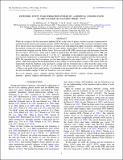EXTENDED, DUSTY STAR FORMATION FUELED BY A RESIDUAL COOLING FLOW IN THE CLUSTER OF GALAXIES SERSIC 159-03
Author(s)
Werner, N.; Oonk, J. B. R.; Veilleux, S.; McDonald, Michael A.
DownloadMcDonald-2015-Extended, dusty star.pdf (2.101Mb)
PUBLISHER_POLICY
Publisher Policy
Article is made available in accordance with the publisher's policy and may be subject to US copyright law. Please refer to the publisher's site for terms of use.
Terms of use
Metadata
Show full item recordAbstract
While the cooling of the hot intracluster medium (ICM) in the cores of galaxy clusters is mostly counteracted by heating from the central active galactic nucleus (AGN), the balance is not perfect. This can lead to residual cooling flows and low-level star formation, the physics of which is not well understood. Here we present a detailed study of the residual cooling flow in the center of the low mass galaxy cluster Sérsic 159-03 (A S1101; z = 0.058) using far-ultraviolet imaging from the Hubble Space Telescope and far-IR (FIR) spectroscopy and photometry from the Herschel Space Observatory, along with a wealth of archival data. We detect extended emission at UV, FIR, and [C ii], indicating a star formation rate of ~1–3 M[subscript ʘ] yr[superscript −1], depending on the indicator and assumptions made. The most recently formed stars (as indicated by high Hα/UV ratios) appear spatially coincident with the lowest entropy ICM. We speculate that this low-entropy gas has been displaced by the central AGN ~7.5 kpc north of the cD galaxy. These data suggest that the displacement of the cooling core from the direct vicinity of the central AGN can temporarily break the feedback cycle and lead to cooling and star formation that is offset from the center of the galaxy. We find an abundance (~10[superscript 7] M[subscript ʘ]) of cold (20 K) dust in the center of the cluster and a second FIR peak ~30 kpc to the north of the central galaxy. If confirmed to be associated with the cooling filaments, this would be the most extended complex of dust yet found in a cool core cluster.
Date issued
2015-04Department
MIT Kavli Institute for Astrophysics and Space ResearchJournal
The Astrophysical Journal
Publisher
IOP Publishing
Citation
McDonald, M., N. Werner, J. B. R. Oonk, and S. Veilleux. “EXTENDED, DUSTY STAR FORMATION FUELED BY A RESIDUAL COOLING FLOW IN THE CLUSTER OF GALAXIES SERSIC 159-03.” The Astrophysical Journal 804, no. 1 (April 24, 2015): 16. © 2015 The American Astronomical Society
Version: Final published version
ISSN
1538-4357
0004-637X